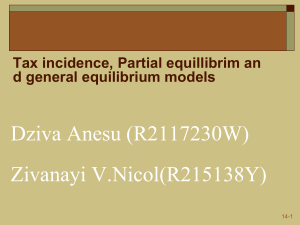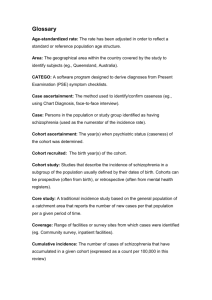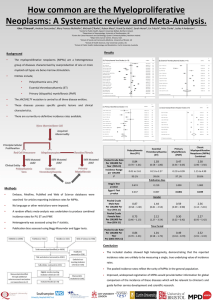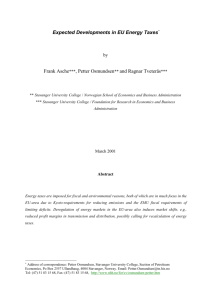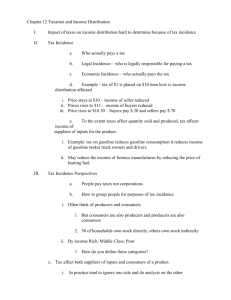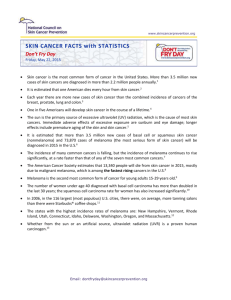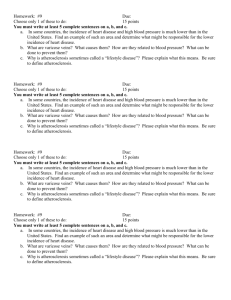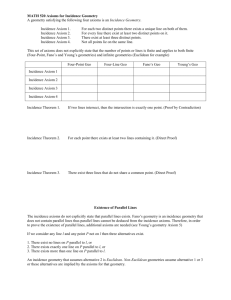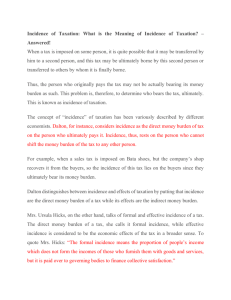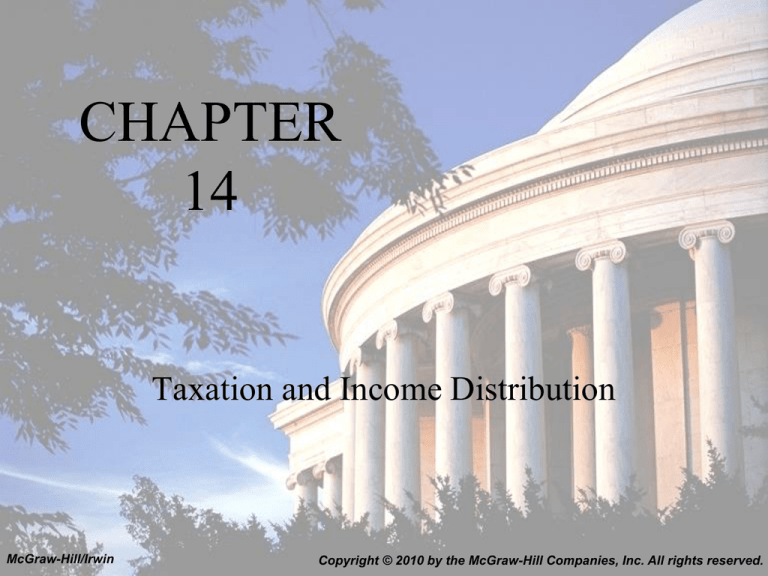
CHAPTER
14
Taxation and Income Distribution
McGraw-Hill/Irwin
Copyright © 2010 by the McGraw-Hill Companies, Inc. All rights reserved.
Vocabulary
•
•
•
•
Statutory Incidence
Economic Incidence
Tax Shifting
Partial Equilibrium Models
14-2
Tax Incidence: General Remarks
• Only people can bear taxes
– Functional distribution of income
– Size distribution of income
• Both sources and uses of income should be considered
• Incidence depends on how prices are determined
• Incidence depends on the disposition of tax revenues
– Balanced-Budget tax incidence
– Differential tax incidence
– Lump-sum tax
– Absolute tax incidence
14-3
Tax Progressiveness Can Be Measured
in Several Ways
• Average tax rate versus
marginal tax rate
• Proportional tax system
• Progressive tax system
• Regressive tax system
Tax Liabilities under a hypothetical tax
system
Income
Tax
Average Marginal
Liability Tax Rate Tax Rate
$2,000
-$200
-0.10
0.2
3,000
0
0
0.2
5,000
400
0.08
0.2
10,000
1,400
0.14
0.2
30,000
5,400
0.18
0.2
14-4
Measuring How Progressive a Tax
System Is
v1
T1
I1
I1 I 0
T0
I0
v2
T1 T0
T0
I1 I 0
I0
14-5
Measuring How Progressive a Tax System
is – A Numerical Example
v1
T1
I1
T0
I0
v2
I1 I 0
.00025
1000 800
300
1000
200
800
.0003
1000 800
360
1000
240
800
T1 T0
T0
I1 I 0
I0
2.0
300 200
200
1000 800
800
2.0
360 240
240
1000 800
800
14-6
$
2.60
Partial
Equilibrium
Models
2.40
2.20
Before Tax
After
Tax
Consumers Pay
$1.20
$1.40
Suppliers Receive
$1.20
$1.00
S1
2.00
S0
1.80
1.60
1.40
1.20
1.00
0.80
D0
0.60
0
1
2
3
4
5
6
D1
7
Quantity
8
14-7
$
2.6
SX
2.4
2.2
2
S
1.8
1.6
1.4
1.2
1
Perfectly
Inelastic
D ’
Supply X
0.8
DX
0.6
0
1
2
3
4
5
6
7
Quantity
8
14-8
$
2.6
2.4
2.2
2
S
1.8
1.6
Perfectly
Elastic
Supply
1.4
SX
1.2
1
0.8
DX’
DX
0.6
0
1
2
3
4
5
6
7 Quantity 8
14-9
Price per Pound of food
Ad Valorem Taxes
Sf
Pr
P0
Pm
Df
Df’
Qr
Q0
Qm
Pounds of food
per year
14-10
Taxes on Factors
• The Payroll Tax
• Capital Taxation in a Global Economy
14-11
Wage rate per hour
The Payroll Tax
SL
Pr
wg = w0
wn
DL
DL’
L0 = L1
Hours per year
14-12
Commodity Taxation without Competition
• Monopoly
• Oligopoly
14-13
Monopoly
$
MXX
c
P0
Pn
i
dh
Economic
Economic Profits
Profits
a
after unit
tax f
g
b
ATCX
ATC0
DX
MRX
X1 X0
MRX’
DX’
X per year
14-14
Profits Taxes
•
•
•
•
Economic profit
Perfect competition
Monopoly
Measuring economic profit
14-15
Tax Incidence and Capitalization
• PR = $R0 + $R1/(1 + r) + $R2/(1 + r)2 + … +
$RT/(1 + r)T
• PR’ = $(R0 – u0) + $(R1 – u1)/(1 + r) + $(R2 –
u2)/(1 + r)2 + … + $(RT – uT)/(1 + r)
• u0 + u1/(1 + r) + u2/(1 + r)2 + … + uT/(1 + r)T
• Capitalization
14-16
General Equilibrium Models
• Partial equilibrium
• General equilibrium
14-17
Tax Equivalence Relations
tKF = a tax on capital used in the production of food
tKM = a tax on capital used in the production of manufactures
tLF = a tax on labor used in the production of food
tLM = a tax on labor used in the production of manufactures
tF = a tax on the consumption of food
tM = a tax on consumption of manufactures
tK = a tax on capital in both sectors
tL = a tax on labor in both sectors
t
= a general income tax
14-18
Tax Equivalence Relations
• Partial factor taxes
tKF
and
and
tKM
tLF
are equivalent to
and
and
tLM
tF
and
are equivalent to
tM
are
are
are
equivalent
equivalent
equivalent
to
to
to
tK
and
tL
are equivalent to
t
Source: McLure [1971].
14-19
The Harberger Model
• Assumptions
– Technology
• Elasticity of substitution
• Capital intensive
• Labor intensive
– Behavior of factor suppliers
– Market structure
– Total factor supplies
– Consumer preferences
– Tax incidence framework
14-20
Analysis of Various Taxes
•
•
•
•
Commodity tax (tF)
Income tax (t)
General tax on labor (tL)
Partial factor tax (tKM)
– Output effect
– Factor substitution effect
14-21
Some Qualifications
• Differences in individuals’ tastes
• Immobile factors
• Variable factor supplies
14-22
An Applied Incidence Study
14-23

